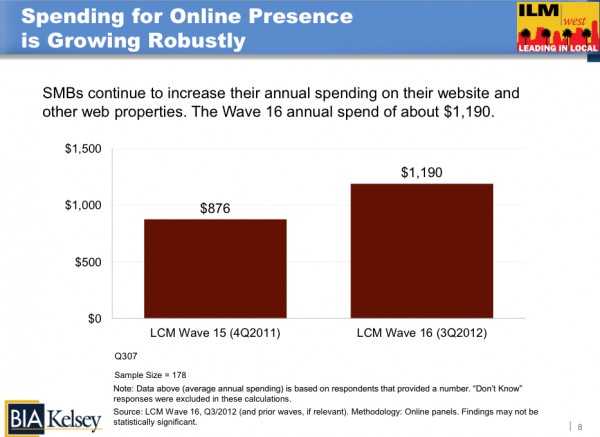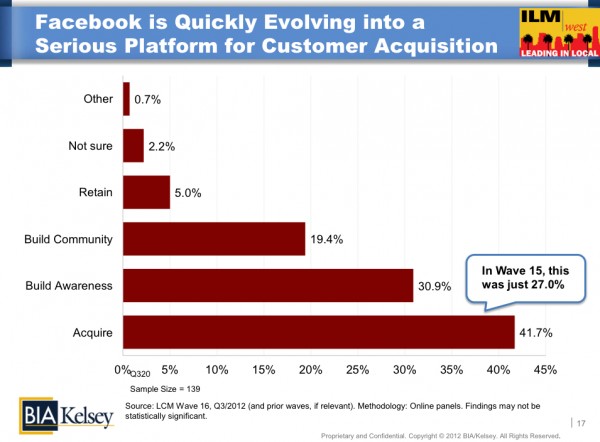7 Key Takeaways From BIA/Kelsey’s ILM Conference
I just returned from the jam-packed annual BIA/Kelsey ILM West conference in Los Angeles, where there was a lot of excitement about what’s next in local SMB advertising. As we head into 2013, local businesses have some important trends to consider when developing their marketing plans. The ways in which consumers are both searching and […]
I just returned from the jam-packed annual BIA/Kelsey ILM West conference in Los Angeles, where there was a lot of excitement about what’s next in local SMB advertising. As we head into 2013, local businesses have some important trends to consider when developing their marketing plans.
The ways in which consumers are both searching and finding local businesses are rapidly changing, and local businesses and marketers are quickly adapting to take advantage of new opportunities to drive business in the door.
Here are my 7 key takeaways from the event:
1. Local Business Spending Remains The Same
But, this spending is increasingly fragmented and focused on online presence. Over the past 12 months, total annual spending on advertising and promotion by SMBs has remained consistent at about $3,000, according to BIA/Kelsey’s Q3 2012 update to its Local Commerce Monitor survey, which was presented at the conference. But the ways SMBs are spending those dollars is increasingly changing.
As the number of media platforms continue to grow, local businesses are broadening their spend. In 2007, SMBs on average used three types of media for advertising and promotion. In 2012, they used 5.8. We can only expect this diversification to continue as new platforms like social media, mobile and tablets take greater hold in the consumer shopping experience.
Today the platform getting the most attention is online, where SMBs are continuing to increase dollars spent on their website and other web properties. They SMBs surveyed by BIA/Kelsey said they spend an average $1,190 on their online presence as of 3Q 2012, up an astounding 36% from $876 in 4Q 2011.
Key takeaway: SMBs shouldn’t worry that the only way to compete in today’s changing media environment is to dedicate more resources to advertising. Rather, they need to strive to spread those dollars across a wider array of platforms to reach consumers in more of the places they’re searching. Right now, many SMBs see building their online presence as an increasingly important part of that effort.
2. Social Media Serves As The Central Platform For SMBs
While SMBs are investing in everything from landing pages to website videos and mobile websites, social media is dominating the field.
The BIA/Kelsey report found that about 63%, or nearly two-thirds, of SMBs said they use social media as a marketing tool for their business. The study showed that 46% of SMBs have a Facebook page, and that an additional 15.3% will likely create one within the next year.
According to data released by Facebook to coincide with ILM West, the number of local business pages advertising on the social network has doubled since January. Local businesses are also doing a better job of keeping pages up to date: active local pages increased more than 40% since January.
Additionally, more than 300,000 pages have promoted more than 2.5 million posts since Promoted Posts for businesses feature launched in June. While Facebook figures don’t focus specifically on SMBs, there’s no doubt that SMB activity is a strong part of this trend.
Key takeaway: SMBs should strongly consider the benefits of building and maintaining their social media presence. Nearly half (49%) of SMBs say Facebook is extremely or very important to their business, according to the BIA/Kelsey study. And it’s no longer seen by SMBs as just a place to build brand awareness or community.
An astounding 41.7% of SMBs surveyed by BIA/Kelsey say they see Facebook most importantly as an acquisition tool. SMBs believe there are transaction opportunities that social media can provide.
3. Customer Loyalty Programs Are Seen As Growing Opportunity For SMBs
A majority of SMBs said they currently have (34%) or are likely to add (21.3%) customer loyalty programs to their marketing mix, according to BIA/Kelsey’s survey. Approximately 53% of SMBs described loyalty customers as “high quality,” and nearly half (49%) said their competitors have loyalty programs already.
Key takeaway: Consumers today have greater access to information when it comes to the businesses they choose and the products and services they buy. A couple looking for a restaurant or a mom shopping for cleaning supplies at the local grocery can easily whip out their cell phones and find reviews, deals and other information that can guide their buying selections.
One of the strongest opportunities to build and maintain momentum for an SMB is to develop customer loyalty programs that have real meaning to the customer and make them feel that the extra dollars they spend with the business are worth it. Their enthusiasm about a business could translate into them checking into a store on Foursquare, tweeting about the business, liking its Facebook page, writing a positive review and a host of other activities that generate important visibility and new business opportunities.
4. As Smartphone Usage Grows, SMBs Are Taking Mobile More Seriously
At ILM West, Mike Boland, program director at BIA/Kelsey, talked about the significant gap that exists today between mobile usage by consumers and the advertising demand that follows.
According to Google Mobile data cited at the conference, 50% of mobile searchers are local. Like all businesses, SMBs have a lot of opportunity – and work to do to – to better connect with new and potential customers in this space.
One area that I’ve discussed previously in this column is the value of creating something as simple as a mobile website, so that consumers searching on their phones can easily access information about a local business. So I’m glad to see that while just 15% of SMBs said they have a mobile website today, a remarkable 52% said they plan to add one in the next 12 months, according to the BIA/Kelsey survey. This represents widespread recognition that mobile is key to the local advertising mix.
But SMBs and local marketers need to more strongly focus on opportunities available in targeted, location-based ads, which are the fastest growing segment of mobile advertising, according to Boland. He discussed how location-based ads have higher click-through rates and also encourage secondary actions in consumers including making a purchase.
Key takeaway: While SMBs are starting to realize that mobile is something they need to invest in, many are just getting started with the basics. And there’s a long way to go.
IdeaLab’s Bill Gross, who delivered the opening keynote at ILM West, talked about creating mobile advertising that adapts to customers depending on their particular wants and situation. He cited an example of a consumer receiving a pizza ad after he tweeted that he’s craving pizza. The opportunity for SMBs to tap into that type of advertising is unprecedented, but it will take a lot of effort and commitment.
5. Show-rooming Phenomenon Is An Increasing Threat To SMB Business
As I mentioned earlier, there’s little stopping a customer from testing an SMB’s products and receiving its expert salesman’s advice, and then taking that information to make their purchase for a cheaper price online.
In a session on local online retail innovation at ILM West, comScore’s Matt Archer shared that 37% of consumers say they have engaged in show-rooming at stores, and that 72% of those say they do so to find a better price online. That trend can only be expected to grow.
In addition to building customer loyalty programs and other initiatives that give consumers incentive to keep their business with the SMBs they visit, local businesses also need to be sensitive to the types of customers walking in their stores and their intentions, so as not to invest valuable time and effort focusing on those who have no intention of making a local purchase. But they should also look for opportunities to play in this new field.
Key takeaway: As show-rooming gains popularity, Google’s Product Listing Ads (PLAs) are emerging as a popular way for retailers to list their products and get found by customers searching for those products.
Kenshoo Local’s Paul Wicker, who once worked as a YP sales rep, said he wants to help SMBs better understand the value of PLAs. He said Kenshoo Local has developed an algorithm to help SMBs increase the impact of the PLAs, noting that beta tests so far have showed positive metrics in terms of cost per call and ad effectiveness. So there are opportunities out there for SMBs to take their share of this growing trend, too.
6. SMBs Need To Continue To Invest In “The Phone Call”
As someone who started in the Yellow Pages business a long time ago, I know the value that SMBs have placed on customer phone calls, which play a big part in the decision-making process for consumers. And while online and mobile advertising gain increasing traction, the old-fashioned phone call is retaining its prominent role – particularly for professional and home services as well as appointment-based companies. As CityGrid’s Jason Finger noted at ILM West, “phone calls aren’t going anywhere for a long time.”
Key takeaway: While SMBs are spreading out their advertising dollars onto new platforms, one fundamental investment that can’t be compromised is ensuring that there’s a voice at the end of the phone. Consumers are increasingly relying on online and mobile in their decision-making process, but often times they want to call up a store and have a direct conversation about the product or service they want to purchase. If no one answers the phone, they are significantly less likely to move forward with that business and will go elsewhere.
7. It’s Time For SMBs To Claim Their Online Directory Listings!
My final takeaway has to do with something I’ve often talked about here in my column: the importance of SMBs claiming their online directory listings. The rationale is simple: with consumers increasingly searching for local business information online and via mobile, SMBs with incomplete or inaccurate information on online directory sites stand the chance of losing easy business.
So I was very surprised to see that only 14% of SMBs have claimed their listings on one of the major online directory sites (and that only 18% plan to do so in the next year), according to BIA/Kelsey’s survey.
Key takeaway: Research has shown that consumers are increasingly looking for basic local business information online: address, phone number, website, social media channels, hours, menus and the like. Most online directories offer local businesses with the opportunity to claim their listings – for free! Therefore, there is no excuse for an SMB not to take the time to claim their listing.
Contributing authors are invited to create content for Search Engine Land and are chosen for their expertise and contribution to the search community. Our contributors work under the oversight of the editorial staff and contributions are checked for quality and relevance to our readers. The opinions they express are their own.
Related stories
New on Search Engine Land

